Wings Over Wairarapa 2009
Having been busy at the time the 2007 show was on I finally made it
again to the airshow the
NZ Sports and Vintage Aviation
Society puts on. This year it was held on the 17th and 18th of
January with the weather turning out a lovely clear sky for the Saturday
I was at the show. Last time I was there not only did I manage to twist
my foot, limiting my mobility, but I spied a tent and grandstand that
had an excellent view of proceedings. I decided then that next time I
wanted to be in that grandstand and accordingly I purchased the more
expensive gold ticket that gives you access to it.
Now regular one day pass tickets are $30 per adult and permit you
access to the bulk of the airshow grounds. Gold tickets are a tad more
pricey at $135 per adult for a one day pass. However they give you
access to a dedicated car park close to the airfield, a grandstand and
dining tent to watch the show from, a complemntary buffet lunch and in
the dining tent a cash bar operating throughout the day. The later
making it easy to keep hydrated through the day as they sold fruit
juice on ice as well as alcoholic drinks. Also in close proximity to the
grandstand were the announcers for the day which meant we often got
involved in the special events like the WWII veterans meet & greet
as well as the Corsair showing off its folding wing action.
Of course the most noteable feature is that the grandstand is
positioned right on the corner of where the two runways intersect and is
the target point that the pilots aim for when performing displays. It
made for an excellent vantage point for seeing the planes in action. Now
if you are here for the planes and want to see them at their best then
the cost of the ticket is entirely worth it. Not only are you in the
best position but, thanks to the cost, the number of people in the gold
area was not huge which kept overcrowding plus rampant small children to
a minimum. Given my experiences at the last show I really enjoyed this
- especially given that the crowd count was being talked up at about
45,000 people present this year. Which, if I remember correctly, is up
about fifteen thousand from the 2005 show.
The one detraction is simply that the size of the crowd is now making
travel to Masterton a slow process. I drove up and while I had allowed
extra time it took me the better part of two hours to get to the car
park, of which a good forty minutes was spent in line waiting to park.
Now this isn't due to a failiure on the part of the show organisers -
traffic wardens were out and in place to direct things. It simply is
that the number of people is reaching a size that I am now wondering if
the aerodrome is capable of adequitely handling it. Certainly if it
keeps growing at the rate it has over the last two years then it is
going to out grow its venue. Which must be a nice problem for the show
runners to have - always nice to have to worry about having a too
successful event...
Not that everything went perfectly for the show. For starters the
wind on the day was a little too gusty to allow the pre-World War I
aircraft to take to the skies. Their low speed and comparitive lightness
meant that trying to fly in such variable wind conditions was a very
good receipe for disaster and while it was a shame to not see them in
the air it was a sensible decision to keep them grounded. Also missing
was one of the stars of the show, a TR 9 Spitfire. Sadly this aircraft
had a bad landing the day before the show. Fortunately no one was hurt
and the aircraft itself is still in good order but damage was sustained
to the prop plus landing gear which rendered the plane not air-worthy
and thus unable to be in the display. This was a shame as I was looking
forward to seeing and hearing this legendary aircraft.
Still there was plenty to see and hear over the day. So shortly
before proceedings kicked off I finished applying sunscreen, made sure
my sun hat was firmly on and keyed up my camera. Now knowing this event
was coming and the difficulty I had with my Canon PowerShot S2 IS I had
planned ahead and finally succumbed to the purchase of a digital SLR.
I've been sitting on my old Canon EOS 500 and lenses for some time now
as I waited for prices to drop. Well that and I was waiting for full
frame sensors to become ubiquitous. Sadly this hasn't really happened so
I have ended up with a 28mm sensor rather than the normal 35mm focal
plate that my lenses are calibrated for. This is what gives the 1.6x
correction factor when using standard lenses. Sadly the camera market,
rather than converging back on a full frame 35mm sensor has instead gone
down the route of adapting the lenses to work with the smaller sensor
size. This isn't a bad approach per se but does mean that when working
with the older lenses you constantly have to do a little mental
arithmetic when working out what were acceptable shutter speeds for a
given focal length.
 But the end results of having a fast focusing proper SLR for taking the
photographs made a big difference. I quickly settled on using my
75-300mm F3.5 lens as the planes were sufficiently high up that I needed
the best focal length I could muster. It doesn't hurt that with the
ultrasonic motors it is a quick and quiet worker too. Combine this with
a Canon 450D back, a polarising filter and an 8Gb card and I was settled
in for a long day of shooting. In the end I came away with about 519
shots - meaning an average of one shot about every 35 seconds for the
entire day. Having more storage on the card than I know what to do with
means that I could be free to experiment a bit without worrying about
either wasting film or running out of space. Digital photography is a
good fit for this kind of event and while I got a lot of rubbish the
strike rate for vaguely decent shots was still around one in five. This
is not to say that I had anywhere near the fanciest kit present on the
day - far from it. As can be seen in the shot to the right several 600mm
F3 lenses turned up. I'd love to have a play with one of those someday.
But the end results of having a fast focusing proper SLR for taking the
photographs made a big difference. I quickly settled on using my
75-300mm F3.5 lens as the planes were sufficiently high up that I needed
the best focal length I could muster. It doesn't hurt that with the
ultrasonic motors it is a quick and quiet worker too. Combine this with
a Canon 450D back, a polarising filter and an 8Gb card and I was settled
in for a long day of shooting. In the end I came away with about 519
shots - meaning an average of one shot about every 35 seconds for the
entire day. Having more storage on the card than I know what to do with
means that I could be free to experiment a bit without worrying about
either wasting film or running out of space. Digital photography is a
good fit for this kind of event and while I got a lot of rubbish the
strike rate for vaguely decent shots was still around one in five. This
is not to say that I had anywhere near the fanciest kit present on the
day - far from it. As can be seen in the shot to the right several 600mm
F3 lenses turned up. I'd love to have a play with one of those someday.
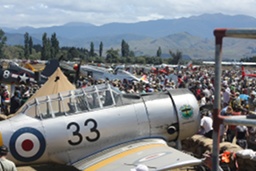 This shot to the left gives an idea of the size and scale of the crowd.
Even this is just a taste of it - I couldn't get a good vantage point to
do an overview of the airfield as a whole but to give you an idea the
crowd extended in similar numbers for around 120 degrees field of view
to the right. Certainly I have to wonder how the locals feel about the
show as it definitely brings Masterton to a halt while the traffic is
streaming in and out. Still a remarkable turn out and while I had the
better viewpoint on the grandstand I also didn't really have time to go
out and see the wide range of stalls and stands present at the show.
Various historical societies looked to have quite interesting displays
present and I aim to make it a point for the next show I attend to
actually go have a look at these. There also were the parked plane
displays which let you have a close look at the hardware which, again, I
mean to actually go do next time. Gives me something to look forward to,
right?
This shot to the left gives an idea of the size and scale of the crowd.
Even this is just a taste of it - I couldn't get a good vantage point to
do an overview of the airfield as a whole but to give you an idea the
crowd extended in similar numbers for around 120 degrees field of view
to the right. Certainly I have to wonder how the locals feel about the
show as it definitely brings Masterton to a halt while the traffic is
streaming in and out. Still a remarkable turn out and while I had the
better viewpoint on the grandstand I also didn't really have time to go
out and see the wide range of stalls and stands present at the show.
Various historical societies looked to have quite interesting displays
present and I aim to make it a point for the next show I attend to
actually go have a look at these. There also were the parked plane
displays which let you have a close look at the hardware which, again, I
mean to actually go do next time. Gives me something to look forward to,
right?
The show itself began with a Kittyhawk P40 and the Albatross L39
doing a brief flight with a passenger each. These seemed to be early
almost unofficial flights to do favours for friends and while very nice
to see the aircraft it marked the start of a slightly muddled approach
to the programme of events through the day. We also got a slightly more
unusual craft in the form of a Gyrocopter. Looking like a helicopter
these unusual craft don't actually power the rotors above the craft to
generate lift. Rather they spin as a result of the forward motion
imparted by the rear facing propellor and sit somewhere between a fixed
wing plane and a helicopter for manuverability with an astonishingly low
stall speed. I half wonder if these flights were done to fill in the gap
left by the pre-WWI planes being unable to fly that day. Certainly the
program that we actually saw was markedly different from the scheduled
one outlined in the show programme.
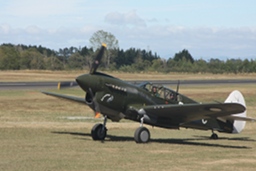
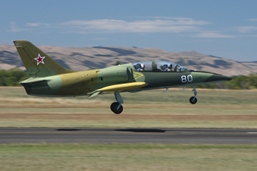
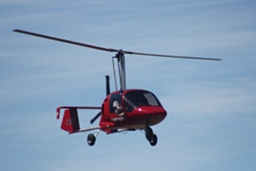
Not all the early airplanes were grounded and we had a selection of
a Gypsy Moth, a Nieuport 11, several Tiger Moths and a German Albatross
DIII flying to represent the early days of powered flight. It is still
remarkable to think that these planes are still under a hundred years
old and were produced within twenty years of powered flight having been
made practical. While they look antiquated and slow they still represent
a huge leap in performance and ability over the Wright brother's flier.
The Tiger Moths travelled as a pair with streamers trailing their wings
which made the twists and turns of their flight that much more graphic
and plain to see.
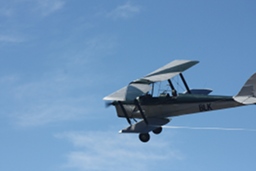
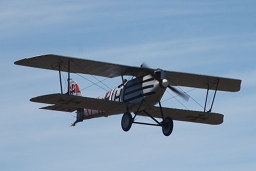
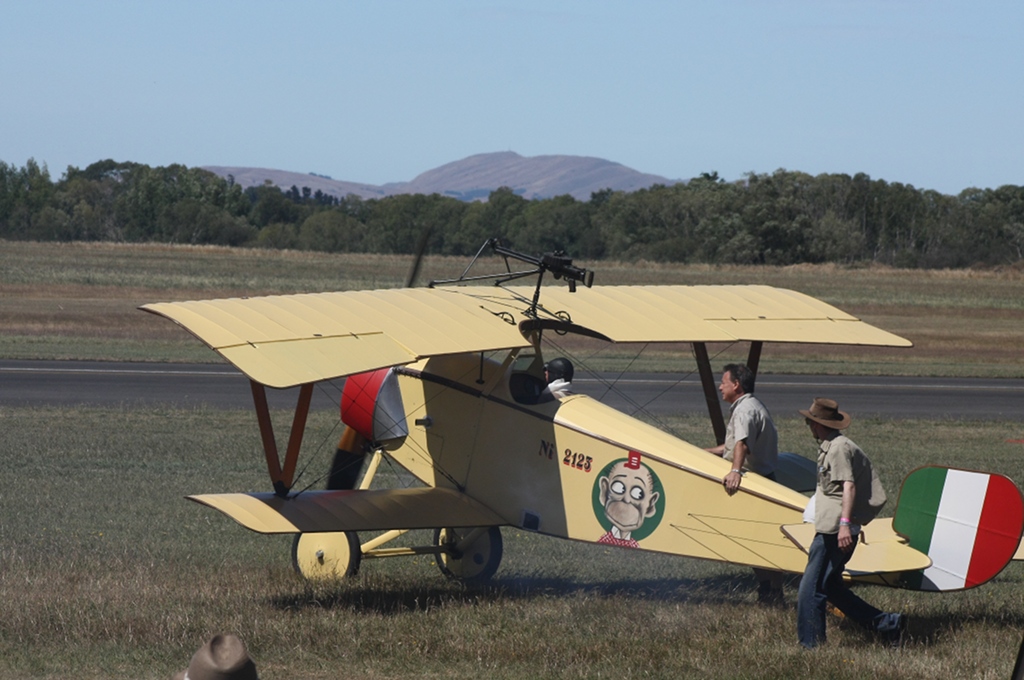
We then got the Yaks doing a degree of racing and display aerobatics
around the airfield. The Yak pilots have been obviously practicing
heavily as their routine was especially smooth and practiced. In fact
out of all the display groups on the day, bar the military, the Yaks
pilots consistantly had clean and well timed aerobatics.
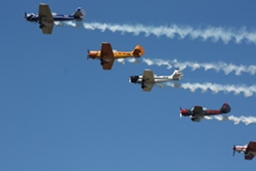
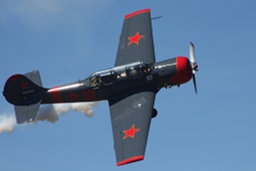
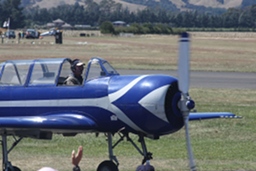
This then led into more specialist aircraft - ones adapted or
developed for roles and New Zealand led the way with one area -
crop-dressing. It seems we were the first to take a
Tiger Moth and
turn the passenger seat into a fertiliser delivery system. This takes
precision flying because you have to fly low and close to the ground. It
also requires take off and landing from difficult, often makeshift,
airfields as well the terrain itself usually being tricky - which is why
aerial dressing is useful. Of course this has developed further with
specialist aircraft, like the Air Tractor, being built expressly for the
job. The tractor is an ungainly looking beast with large oversize wings,
a high mounted cockpit and overall stubby looks with its short length
compared to the wing span. It makes up for it in low speed low altitude
maneuverability as well carrying ability - around 1.4 tonnes of
fertiliser per plane load.
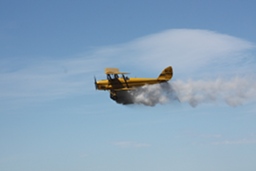
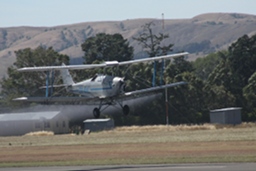
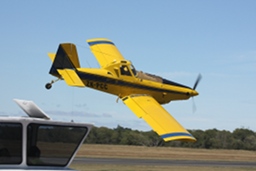
The Harvards
then got into the act with their own 'Roaring 40s' display act. This was
a solid routine with some very tidy flying but in my opinion it lacked a
little of the flair that the Yaks showed. This might be because the
Harvards fly differently from the Yaks and limit matters a bit - I don't
know.
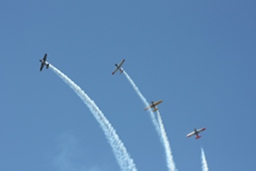
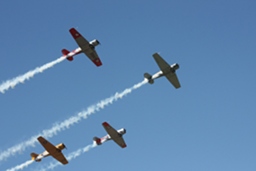
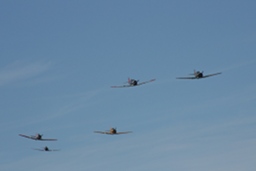
Lunch then was served and a brief break in the flying then occured.
It resumed with an oldy but a favourite of mine - the
de Havilland DH 115 T.55 Vampire
jet. From the sound and the clearly Thunderbirds inspiring shape of it
just tickles that inner kid in me that used to watch the show
religiously loving the big chunky machinery it featured. Somehow the
modern machines haven't quite got the same visual charm which is why it
is still a thrill to see this plane in action.

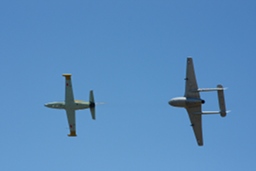

With the jets safely landed the focus of the show shifted to the
second world war planes in the pacific. In particular the
Curtiss P-40E Kittyhawk
and the
Consolidated PBY-5A Catalina.
Again the Catalina is one of those planes that is easily recognised and
well liked by many. Interestingly they were offering a ride in the plane
this show and without knowing the pricing asked for this I was sorely
tempted. Getting a chance to actually fly in one of these unique
machines would be quite the buzz I suspect. Especially given that, due
to its low airspeed and large observation blisters, the view from it
would be especially good. It also helps that this plane has the same
distinctive engine drone as the DC3 Dakota.
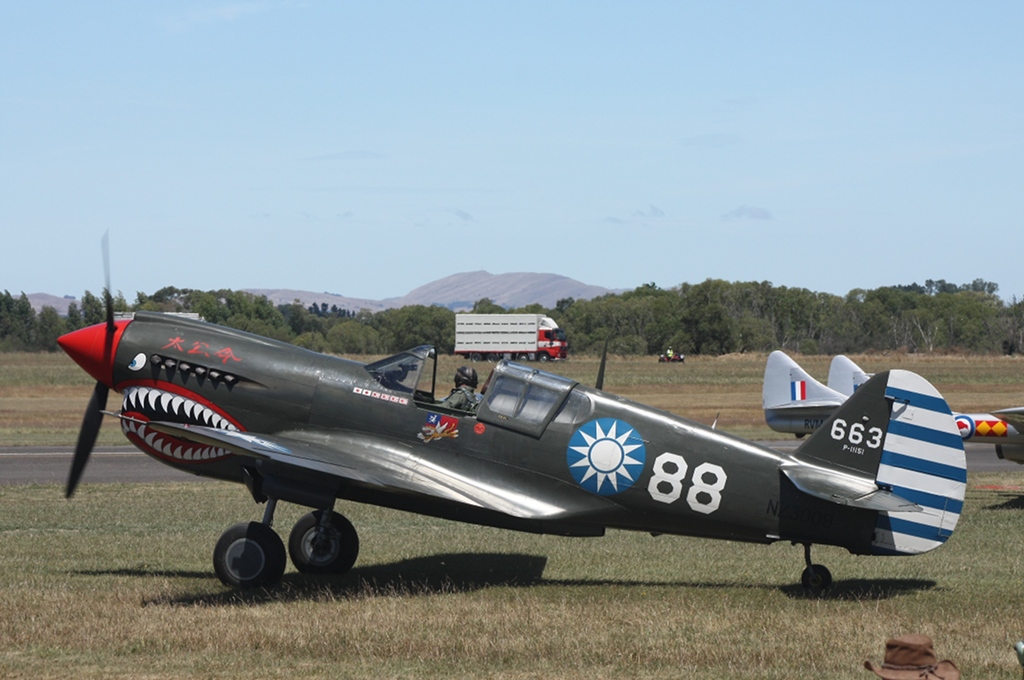
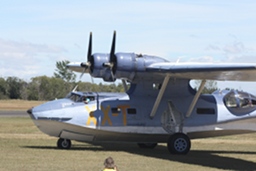
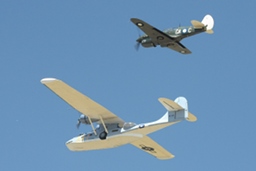

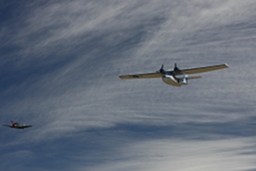

While the Catalina and the Kittyhawks were doing their thing one of
the monsters of WW2 was doing its party trick down on the airfield. I
am referring, of course, to the
FG-1D Corsair.
The party trick is the ability of the Corsair to fold its wings, a vital
part of its utility in Naval use off aircraft carriers. So to this end
the Corsair rolled up in front of the mess tent and grandstand area to
show us it folding and unfolding its wings. What someone forgot is that
part of the reason the Corsair has the gull wing step is that it has an
exceptionally large propellor diameter and is quite capable of shifting
large volumes of air. Add to this a slightly heavy aircraft and you can
probably guess what happened with the Corsair rotated around to then
taxi onto the runway and takeoff. Yep, several missing hats and quite a
few forcibly closed umbrellas later and I strongly suspect we won't be
seeing this done at future airshows. Certainly not right up close to the
dining area...
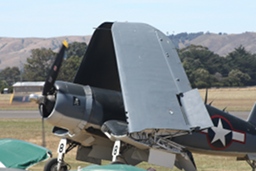
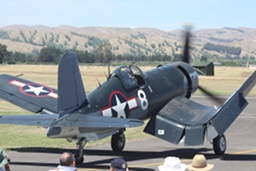
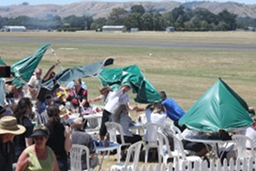

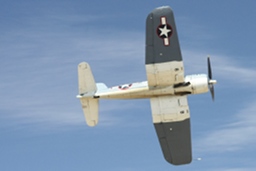
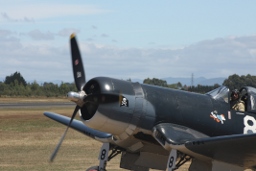
So we had a break for lunch in which the Yaks and a MX2 stunt plane
putting on various aerobatic moves. I missed most of this because the
pangs of hunger had kicked in and I was in the lunch line inside the
tent. This meant I could hear beautifully what was going on but not see
a heck of a lot. That and the camera took a well earned rest as well. So
with victuals in hand I got back in position on the grandstand in time
to see the NZ Army begin their display. Now during the day we had a
local celebrity announcer, one Jim Hickey, whose biggest claim to fame
is presenting the weather forecast on one of the nations network news
channels. He and a more local aviation enthusiast provided the audio
commentary by loudspeaker for all the proceedings. Having done some
digging I can see why he was chosen - he has a pilots licence himself
and has made a documentary series involving him using a Cesna to fly
himself into the more remote portions of New Zealand. Clearly he has a
more than passing interest in aviation and it doesn't hurt that he is
generally well liked for his weather presentation.
Unfortunately this didn't translate into a particularly interesting
commentary as he spent most of the day either simply describing what
the planes were doing without going into much background on why the
plane is doing it or the history of the planes themselves. His local
partner did try to colour in some details but was often over-ridden by
Jim either joking about something or once again just describing what the
planes were doing. What really irked me though was that during the army
display we had a female officer come up to the announcing platform to
fill us in on what the army pilots were doing. She was excellent in not
only informing us to what the maneuver is for but also giving us some
background on the pilots performing them as well. What she got from Mr
Hickey was a number of, frankly, chauvanistic comments masqerading as
joking as he complained about women pilots maneuvering badly and a bunch
of other sexist nonsense. Not only is this a shame and slightly
embarrasing to hear but it meant that this commentary simply wasn't a
patch on the one provided over the 2005 airshow. That commentary told
you a lot on the history of the planes, the roles they were used in and
their overall significance to aviation history. If I might be so bold
I'd strongly suggest to the S.V.A.S. people organising the airshow to
resist the tempation to go for 'celebrity' and keep the people they have
been using to do the commentary.
As for the Army display itself, this was quite a bit of fun with a
squadron of Iroquois
helicopters demonstrating their abilities with a variety of maneuvers.
One often demonstrated skill was that of lifting and hoisting with some
hapless car being dropped to show the lifting power of the helicopter.
Naturally the joke was that this car was parked incorrectly and the army
was helping with parking enforcement. Also demonstrated was winching of
people and fire-fighting loads. The Iroquois has a very distinctive
noise when operating and of course has a heavy association with the
Vietnam war where they were used heavily for the first time as the Air
Cavalry.
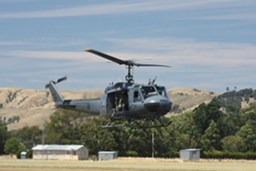
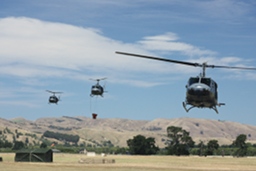
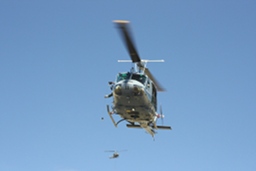
Backing them up was a pair of Sioux
scouting helicopters. These are somewhat slow beasts that I couldn't
help but wonder how many pilots were overly exposed to enemy fire due to
the low height and slow speed of these machines. We then got two
Iroquois 'dancing' with each other. This meant they rotated around
facing each other as they moved up the airfield. A tricky bit of flying
and done really well by the air force pilots here.
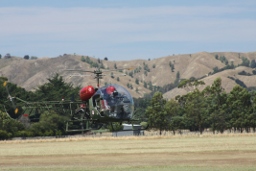


The final armed forces helicopter to feature was the Navy's new
Seasprite. While not the most beautiful of machines to look at it
certainly is a very functional beast and it performed a variety of tasks
including a rapid fast rope deployment of a platoon of troops, winching
someone up from a moving car and general hovering about while putting
the landing gear up & down. The armed forces display continued with a
parachute team dropping in. As they came down they were trailing smoke
canisters that potentially could set things alight, like parachutes for
instance, due to the heat they operate at. Seems slightly mad strapping
such a hot item to your ankle if you ask me but they carried the jump
off without incident.
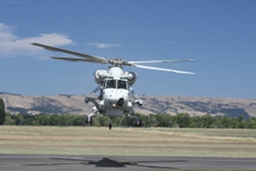
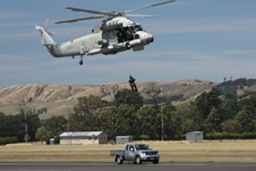
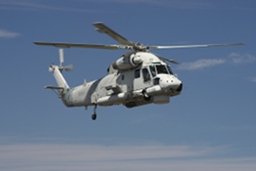
This left the most dynamic of the airforce displays - the Red
Checkers, who are our aerobatic display team in the airforce. Their
five planes put on a really excellent display with some very tight
formation flying doing a variety of loops, turns and synchronised
maneuvers. It seems that having the professionals there put the pressure
on with the Yak pilots who then did their own large wing of formation
flying with all eight executing some loops and rolls together. Having a
numerical edge they exploited this putting on some very impressive large
wing formation flights.
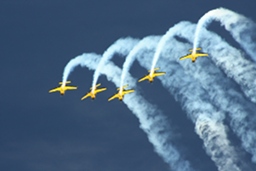
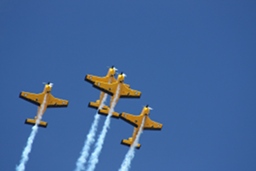
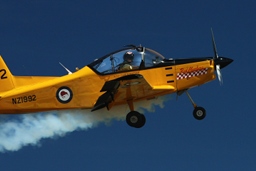

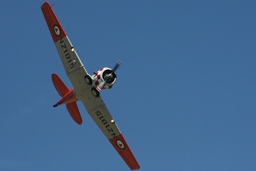
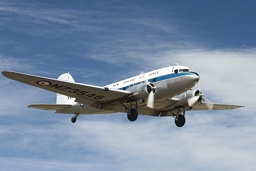

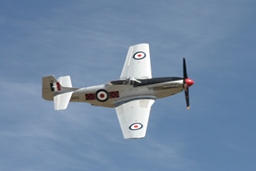
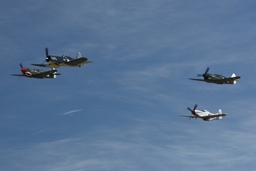
We then had a tribute to the RAF with planes fropm WW1 and WW2
featured including a stalwart - the DC3 Dakota. Here it was painted in
RNZAF colours and in many ways provided me with one of the best shots I
got from the entire airshow. Once the warbirds had swung past and the
civilian planes had touched down again we got the Airfield Attack
segment. This is the shows big finale where a staged mock battle takes
place over the airfield. At least that is the plan and certainly
something did happen over the airfield but in perhaps the weakest note
of the whole show the attack was all taking place just a little too far
away from the crowds to really see. It was co-ordinated with soldiers on
the ground, a Valentine tank and other support vehicles. All of these
were also staged on the far side of the runway.
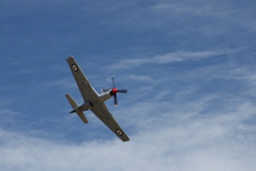
Now I don't know if this was a safety measure or not but the end
result was that it was very hard to make any sense of what was going
on. Another change this year was the absence of the gun simulator used
in the 2005 version of this. The end result is that the dogfight was
largely a lot of circling with some difficulty actually telling what was
going on. Similarly the ground forces who were evidently having a good
time out there staging their mock battle were nearly impossible to see
clearly. It seems such a shame to go to all that effort and have such a
muddly event to follow. That said having so many planes active at once
in the sky still made for a strong conclusion to the day and the
begining of the journey home. The last shot I want to use on this page
is the one of the Mustang banking off into the sky. For me it
encapsulates a lot of what the airshow is about and the spirit of
aviation.
Finally for the photography nerds out there the images used on this
page have been largely untouched. One or two have been cropped. Having
recently got my hands on a copy of Lightroom I've begun to discover the
extent to which a digital image can be manipulated even before you put
it into a heavy duty tool like Photoshop. At the time of typing this I
have played with several images - including the shot of the DC3
Dakota. These can be found over on the
Backdrops
page of this site. A modicum of tweaking has improved the images no end.
Philip R. Banks
Send Email
 But the end results of having a fast focusing proper SLR for taking the
photographs made a big difference. I quickly settled on using my
75-300mm F3.5 lens as the planes were sufficiently high up that I needed
the best focal length I could muster. It doesn't hurt that with the
ultrasonic motors it is a quick and quiet worker too. Combine this with
a Canon 450D back, a polarising filter and an 8Gb card and I was settled
in for a long day of shooting. In the end I came away with about 519
shots - meaning an average of one shot about every 35 seconds for the
entire day. Having more storage on the card than I know what to do with
means that I could be free to experiment a bit without worrying about
either wasting film or running out of space. Digital photography is a
good fit for this kind of event and while I got a lot of rubbish the
strike rate for vaguely decent shots was still around one in five. This
is not to say that I had anywhere near the fanciest kit present on the
day - far from it. As can be seen in the shot to the right several 600mm
F3 lenses turned up. I'd love to have a play with one of those someday.
But the end results of having a fast focusing proper SLR for taking the
photographs made a big difference. I quickly settled on using my
75-300mm F3.5 lens as the planes were sufficiently high up that I needed
the best focal length I could muster. It doesn't hurt that with the
ultrasonic motors it is a quick and quiet worker too. Combine this with
a Canon 450D back, a polarising filter and an 8Gb card and I was settled
in for a long day of shooting. In the end I came away with about 519
shots - meaning an average of one shot about every 35 seconds for the
entire day. Having more storage on the card than I know what to do with
means that I could be free to experiment a bit without worrying about
either wasting film or running out of space. Digital photography is a
good fit for this kind of event and while I got a lot of rubbish the
strike rate for vaguely decent shots was still around one in five. This
is not to say that I had anywhere near the fanciest kit present on the
day - far from it. As can be seen in the shot to the right several 600mm
F3 lenses turned up. I'd love to have a play with one of those someday.














































